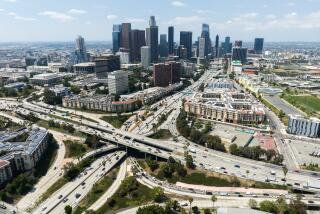MTA’s Plans to Cut Bus Service Dismay Riders
- Share via
Trini Chaney’s reaction to the proposed reduction of bus service along Nordhoff Street in Northridge was quick and easy.
“It’s ridiculous,” Chaney, 27, of Van Nuys, said while waiting for the No. 166 bus at Nordhoff and Reseda Boulevard. “This bus barely runs enough already.”
Chaney, like other bus riders and their advocates throughout Los Angeles, was less than thrilled with the Metropolitan Transportation Authority’s plans to reduce some off-peak bus service and raise rail fares 50 cents to help improve the struggling agency’s bottom line. It is tens of millions of dollars in the red.
So along Line 166, some bus riders may soon routinely experience one-hour waits, up from 30 minutes, between 9 a.m. and 3 p.m.
“If anything, they should run more--every 20 minutes at least,” said Chaney, who was concerned about being late for work at a nearby department store.
Gloria Cruz, 21, of Northridge, who was waiting with Chaney, could barely believe it.
“Oh, no,” said Cruz, who was headed for work at a fast-food restaurant. “Oh, my gosh.”
The Bus Riders Union, a civil rights group that previously sued the MTA seeking reforms, has vowed to fight any service reductions.
*
But MTA officials said the proposal, announced Nov. 10 by the agency’s chief executive, Julian Burke, concentrates on lightly used routes and should not cause alarm for most riders. It involves less than half of the MTA’s roughly 180 bus lines, and only about 10% of all riders.
“We’re looking at the potential to reduce duplication of service,” said Dana Woodbury, a deputy executive officer for the MTA. “Riders wouldn’t be abandoned.”
Woodbury said light usage generally was defined as fewer than 20 passenger boardings per hour along a given route. Although the routes vary in length, most are in the 10- to 20-mile range, he said.
“Twenty boardings an hour is very low demand for a fixed route service,” he said. “These lines were considerably below that.”
Alternatives for riders will include measures such as the so-called smart shuttles with flexible routes, which began operating recently.
Woodbury said riders generally will not be expected to walk more than a quarter-mile from their normal stops to find an alternative that will meet their needs. For example, riders may need to walk a bit farther to use a parallel bus route, he said.
“It’ll be less convenient for them,” he said. “Apart from that, service will still be available.”
Indeed, some of the proposed reductions are so slight that waiting periods at bus stops would increase only by one minute--from about 10 minutes to 11 minutes.
It is all necessary, MTA officials said, if the transit agency is to have any hope of eliminating a $50.6-million deficit.
The overhaul announced by Burke includes raising the fare for MTA rail lines from $1.35 to $1.85, effective in April. A $15-per-month surcharge for use of rail service would be added for those purchasing $42 monthly bus passes.
“It’s driven by the bottom-line needs to reduce expenses,” Woodbury said.
But those needs create other problems.
“It’s going to be devastating for people,” said Martin Hernandez, an organizer for the Bus Riders Union. “We’re going to fight it.”
Hernandez said the proposal will be challenged in meetings with MTA officials as well as in court, if necessary. The nonprofit organization previously challenged the MTA in court by alleging that massive spending on rail projects diverted funds from low-income and minority bus riders.
In an October 1996 settlement, the MTA promised to reduce overcrowding, improve existing services and add new routes and more buses.
*
The settlement also called for the MTA to freeze the $1.35 cash fare and the 90-cent token price for buses for two years; increase security; continue the sale of monthly passes for three years, cutting the price from $49 to $42; and provide 15-day passes for $21 and weekly passes for $11.
Hernandez and supporters said that any fare increase, even on the rail service, seems to violate the consent decree.
Already, previous service changes have forced some bus riders onto the rail system, they said.
“Now they’re saying you’ve got to pay more money [to ride the trains],” Hernandez said. “That’s ridiculous.”
More to Read
Sign up for Essential California
The most important California stories and recommendations in your inbox every morning.
You may occasionally receive promotional content from the Los Angeles Times.










